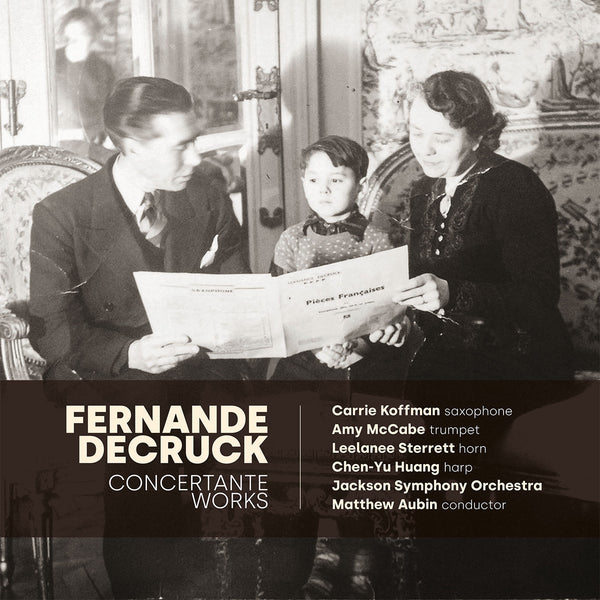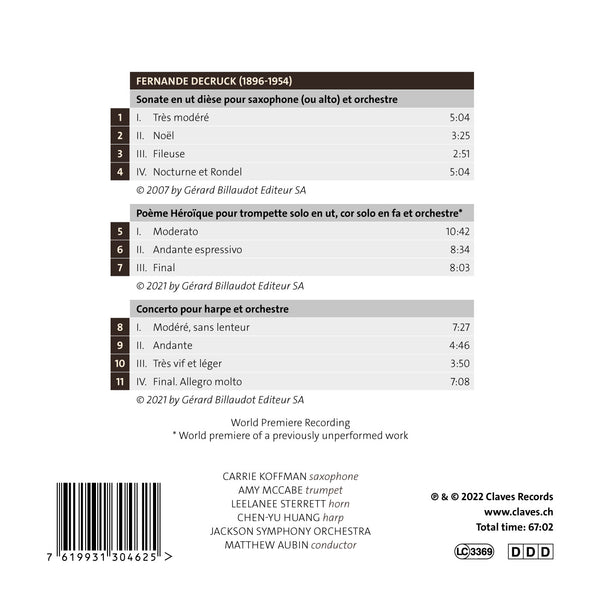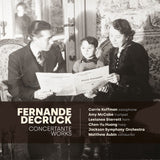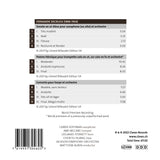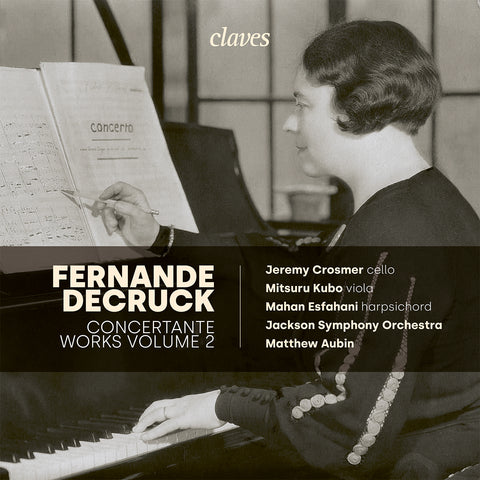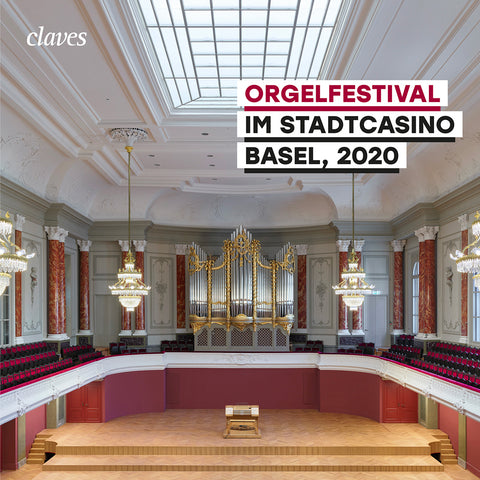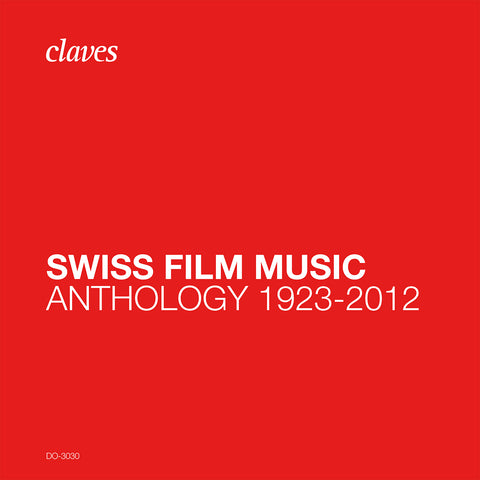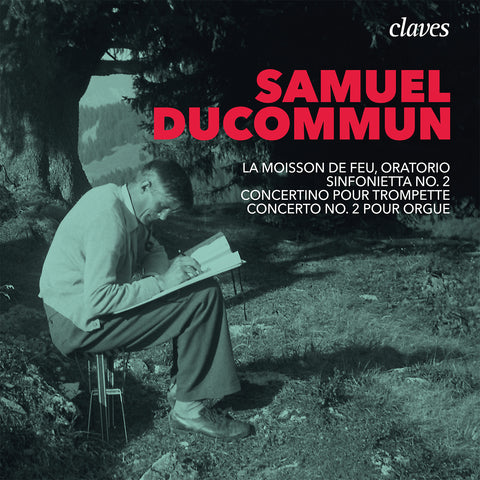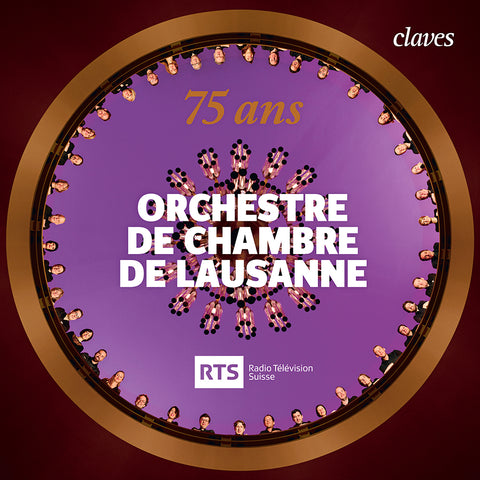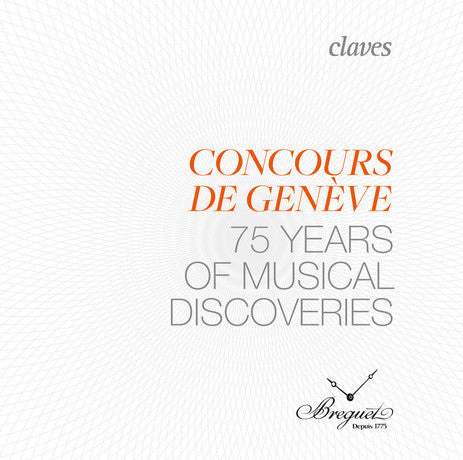(2022) Fernande Decruck: Concertante Works
Category(ies): Brass Orchestra Rarities
Instrument(s): Harp Horn Saxophone Trumpet
Main Composer: Fernande Decruck
Orchestra: Jackson Symphony Orchestra
Conductor: Matthew Aubin
CD set: 1
Catalog N°:
CD 3046
Release: 10.06.2022
EAN/UPC: 7619931304625
This album is now on repressing. Pre-order it at a special price now.
CHF 18.50
This album has not been released yet. Pre-order it from now.
CHF 18.50
CHF 18.50
VAT included for Switzerland & UE
Free shipping
VAT included for Switzerland & UE
Free shipping
This album is now on repressing. Pre-order it at a special price now.
CHF 18.50
This album has not been released yet.
Pre-order it at a special price now.
CHF 18.50
CHF 18.50
FERNANDE DECRUCK: CONCERTANTE WORKS
ABOUT THIS ALBUM
Sonata in C-sharp for alto saxophone (or viola) and orchestra (1943)
Carrie Koffman – saxophone
The Sonata in C-sharp for alto saxophone (or viola) is Decruck’s best-known work. Decruck created two versions of her world-famous sonata, one with saxophone or viola and piano, the other with full orchestral accompaniment. The latter version is rarely heard. Decruck combines the classical sonata form with impressionistic harmony and, at times, polytonality. Decruck dedicated this work to Marcel Mule, the world-renowned French saxophonist. Although Mule had countless compositions written for him in his lifetime, he took the time to record the Fileuse movement of the Sonata.
The first movement begins mysteriously in the orchestra before unfolding to a pastoral melody featuring the soloist and orchestra in dialogue. The second movement, Noël, references Noël Nouvelet (“Christmas Comes Anew”), a traditional French carol and is infused with melancholy. Fileuse (“spinning”) features the saxophonist performing virtuosic passage work and takes the traditional place of the Scherzo. The finale is structured in two parts. The Nocturne again has a mysterious feel while also evoking a funeral march before transitioning to the Rondel section, which brings the work to a heroic close.
Heroic Poem for solo trumpet in C, solo horn in F and orchestra (1946)
Amy McCabe – trumpet & Leelanee Sterrett – horn
Written in 1946, Poème Héroïque is a double concerto for solo trumpet, solo horn and orchestra. The work often features the two solo instruments in imitation and is a fantastic example of Decruck’s mature style. Divided into 3 contrasting movements, the piece sounds more American and Neo-Romantic than French. At times, it can sound mysterious and ethereal. Other sections have a driving, perpetual motion character. Decruck experiments using contrasting time signatures like 24/16 and 2/4. Whether the work was ever performed or who it was written for is unknown. Decruck moved to Marblehead, Massachusetts, the following year. In 1948, she created a reduction of the work for solo trumpet and piano. This version was written for Roger Voisin, the famous French principal trumpet of the Boston Symphony Orchestra.
Concerto for harp and orchestra (1944)
Chen-Yu Huang – Harp
The Concerto pour harpe et orchestre was dedicated to and premiered by French harpist and pedagogue Pierre Jamet in 1946. Jamet later became the harp professor at the Paris Conservatoire in 1948. Decruck’s Concerto shares similarities with Germaine Tailleferre’s Sonate pour harpe. It is a concertino in style, light-hearted, warm, and full of surprises. At the premiere performance by Concerts Colonne, the critic Henry Malherbe commented that the Concerto was “A work of lively and delicate feeling. A renowned harpist, Pierre Jamet, has carved out a great success.” Decruck must not have been fully satisfied, though. In her definitive score, she states that the original fourth movement, a fughetta, should be suppressed. The present recording respects her wishes.
Matthew Aubin
Read more, bios & and French texts in the booklet
***
FERNANDE DECRUCK
French composer Fernande Breilh-Decruck showed signs of a promising career from an early age, when she won several prizes at the Conservatoire National Supérieur de Paris (harmony, fugue, piano). As an assistant professor of harmony, she trained many students, including one who became very famous and later dedicated her a score: “To Fernande Decruck, with all the gratitude and fond memories of the author – Olivier Messiaen”.
From 1926, the year of his appointment as organ teacher, Marcel Dupré introduced her to improvisation. This talent earned her an organ concert tour in the United States at the end of 1928. She later gave solo recitals in New York City’s grand auditoriums. Decruck’s trajectory as a composer can be traced through her early works, which give prominence to the organ (her instrument), saxophone and double bass (her husband’s instruments). The Decrucks lived in New York City for several years. Her husband Maurice played double bass and saxophone in the New York Philharmonic under Arturo Toscanini.
Decruck’s American period saw the birth of numerous compositions for piano, organ, orchestra, a concerto for cello and orchestra, and many works for a wide range of wind instruments, notably for saxophone.
In 1937, Fernande Decruck moved to Toulouse alone with her three children. She worked as a professor at the Toulouse Conservatory. From 1942 onwards, she devoted herself entirely to composition, notably writing a harp concerto, Poème héroïque, and the Sonata in C-sharp for saxophone. She officially divorced Maurice in 1950, which led to financial difficulties. She ended her career as a professor of harmony at the Fontainebleau Conservatory. A series of health problems led to her untimely death at the age of 57.
***
See the booklet for biographies of the artists (ENG - FR)
***
MATTHEW AUBIN
A leader in the 21st-century orchestral landscape, Dr. Matthew Aubin is constantly reaching new audiences through innovative performance formats and creative initiatives both on and off the podium.
In his 5th season as Music Director of the Jackson Symphony Orchestra, Dr. Aubin also serves as Artistic Director for The Chelsea Symphony in New York City. In this role, he has led notable collaborations with partners such as actor John Lithgow, award-winning television series Mozart in the Jungle, and the American Museum of Natural History in New York City. Dr. Aubin has played a principal role in the initiation and development of The The Chelsea Symphony’s annual competition for emerging composers with high profile adjudicators such as Conductor Laureate of the Seattle Symphony and music director of the All-Star Orchestra, Gerard Schwarz. Dr. Aubin has led TCS in their Lincoln Center debut and conducted the New York City premieres of works by Mark O'Connor, Fazil Say and Caroline Shaw, among others.
As a consultant for the Amazon Prime series Mozart in the Jungle created by Roman Coppola and Jason Schwartzman, Dr. Aubin was the off-camera conductor for an episode filmed on Rikers Island. Since then, Dr. Aubin has continued a relationship with the NYC Department of Correction, designing and conducting a series of concerts and education initiatives for detainees, both in-person and online. He also served as the onstage conductor for the film Bel Canto with Julianne Moore and has been an artistic consultant for the hit television show Younger.
As Music Director of the Jackson Symphony Orchestra, Dr. Aubin has transformed the orchestra’s visibility, both in the community and on a national scale. He has collaborated with world-renowned soloists such as pianist Pascal Rogé, cellist and composer Jeremy Crosmer, cellist Julian Schwarz, and composer Lowell Liebermann. During Dr. Aubin’s time as Music Director, the JSO’s season has expanded. The organization is now regularly reaching audiences of all ages through expanded family concerts, education concerts, and the JSO’s Music on Tap series geared towards young adults. During the 2020 pandemic, he launched a series of digital initiatives, most notably the Random Acts of Music series. Under Dr. Aubin's leadership, the JSO also released a series of asynchronous, multimedia educational videos to be used in K-12 classrooms. These videos were based on the 2021 season's virtual programming and explored musical concepts.
Dr. Aubin is the foremost scholar on the French composer Fernande Breilh-Decruck. He has earned multiple research grants to study her significant life and work. A champion of the critical role of women in composition, Dr. Aubin is working to promote Decruck’s newly discovered lost music. He has edited and created critical editions of her work, which are now in the process of publication with the French publishing firm Gérard Billaudot, and has organized performances of Decruck’s music in the United States and abroad. The 2021-2022 season brings a large-scale recording project of Decruck’s orchestral works aimed at giving orchestras further access and insight into her brilliant work.
Dr. Aubin continues to be active as a freelance horn player and regularly performs across the country. A devoted music educator, Dr. Aubin’s past associations include Assistant Professor of Music at Washington State University, Adjunct faculty at The Hartt School and Educational Programs Conductor for the Hartford Symphony Orchestra.
***
Carrie Koffman, saxophone
Amy McCabe, trumpet
Leelanee Sterrett, horn
Chen-Yu Huang, harp
Jackson Symphony Orchestra, Matthew Aubin
REVIEWS
“[..] Harpist Chen-Yu Huang leads a talented group of soloists, all women, but perhaps the biggest star is conductor Matthew Aubin, a specialist in Decruck's music who leads the Jackson (Michigan) Symphony Orchestra. This group is little known, but it's safe to assume that here, it has played beyond its general capabilities. This album is a real revelation, necessary in any collection of 20th century French music.” - James Manheim, August 2022
“[..] The Jackson Symphony sounds magnificent, and due credit must be given to the musicians of the orchestra whose fine solo playing appears in all the works. Congratulations to Matthew Aubin for his scholarly and musical leadership in breathing new life into these works. [..]” - Rebecca Davis, November 2022
« [..] Die nun erscheinende Sammlung ausgewählter Orchesterwerke zeigt eine wagemutige Komponistin am Übergang von Neoklassizismus und Impressionismus zur Neuen Musik. Ihre Werke für Saxofon (Carrie Koffman), Trompete und Horn (Amy McCabe und Leelanee Sterrett) und Harfe (Chen-Yu Huang) begleitet das Jackson Symphony Orchestra unter Matthew Aubin. » - Frank von Niederhäusern, Juli 2022
« À travers ces trois enregistrements en première mondiale, on redécouvre une petite partie de l’œuvre de la prolifique compositrice française Fernande Decruck. Des nombreuses pièces qu'elle consacra au saxophone, c’est la sonate en ut dièse (1943) qui est la plus renommée dans sa version pour saxophone alto et piano. Elle est ici enregistrée pour la première fois avec orchestre. Le velouté, la clarté et l’agilité virtuose et mélodieuse de l’instrument y trouve un écrin de choix. Il y est enrobé d'une riche et chaleureuse orchestration sublimant une composition à la musicalité enchanteresse et à la finesse remarquable. Tout aussi riche et expressif est le « Poème héroïque » pour trompette, cor et orchestre (1946). [..] » - Laurent Mineau, septembre 2022
“[..] Matthew Aubin’s ability to reawaken music of the unheard is what discovery is all about. We champion his efforts as we graciously experience the talents of the Jackson Symphony Orchestra on this CD. Intriguing music and well‑worth a visit.” - Christie Grimstad, November 2022
« [..] Au fil de ces partitions dont la mise en évidence est une initiative qu’il faut saluer, Fernande Decruck se révèle habile dans l’art de l’orchestration, que le Jackson Symphony Orchestra du Michigan, qui existe depuis 1949, sait révéler avec justesse sous la baguette de son directeur musical depuis 2017, Matthew Aubin, qui a une formation de corniste. La notice signale qu’il est un grand défenseur des compositrices, et un spécialiste de Fernande Debruck à laquelle il a consacré, grâce à l’obtention de bourses, des recherches poussées et des éditions critiques. Il a organisé à sa mémoire une série de concerts. Le présent album est en quelque sorte un point d’orgue de cet intérêt qui devrait se poursuivre par d’autres enregistrements. [..] » - Jean Lacroix, juin 2022
« Das Album ist somit ein gelungenes Beispiel für die Wiederentdeckung vergessener Komponistinnen, die seit ungefähr zehn Jahren zu einem markanten Merkmal des Musikbetriebs im Bereich ‘klassischer Musik’ und der Musikforschung geworden ist. Die gegenseitige Ergänzung von Praxis und Forschung verkörpert in diesem Fall der promovierte Dirigent Matthew Aubin, der als »foremost scholar on the French composer« (S. 15) vorgestellt wird und sowohl die musikalische Leitung als auch den Begleittext übernommen hat. [..] Nichtsdestotrotz, wegen der Qualität der Aufnahme und der Auswahl der Werke, erscheint die CD als wertvolle Rarität und wichtiger Beitrag zur klingenden Geschichte von Komponistinnen und der klassischen Moderne. » - Louis Delpech, Oktober 2022
“This is the inaugural recording in the Jackson (MI) Symphony’s newly launched Equal Billing Project that aims to record music of deceased composers who weren’t adequately recognized during their lifetimes. Music Director Matthew Aubin discovered the music of Fernande Decruck (1896–1954) when working on his doctorate. She taught composition at the Paris Conservatory, studied organ and improvisation with Marcel Dupré, and lived for a while in New York City when her husband played double bass and saxophone in the New York Philharmonic under Toscanini. Based on the three works presented here, Decruck integrates the sound worlds of César Franck, Debussy, and Ravel into her own approach to form, lyricism, texture, and drama. [..]” - Gil French, December 2022
“Fernande Decruck is hardly a household name, yet, in the world of classical saxophone at least, she has become one over the past couple of decades. Her Sonate en C# has cemented itself as a staple for the instrument. This release on Claves provides an opportunity not only to hear that work in its orchestral version but also two other fine concertante works. [..] Matthew Aubin has done a fine job with this recording and it is obviously a labor of love. It is recorded vividly by Claves and I certainly hope that this proves to be the first of several recordings of Decruck’s music from this team. [..]” - Raphael Marsonet, October 2022
“[..] Her music is rooted in an amalgam of baroque and classical-romantic styles. Clinging to long established traditions, this means easily accessible music with a generally strong melancholic streak. The fact that she must have been a distinguished teacher is evident not least from her composition and instrumentation technique, for there is plenty of that. Yet her work is not of such a nature that it will ever be able to free itself from the crowded periphery of lesser gods. That the Claves label pays attention to her work is, however, certainly from a Swiss perspective, entirely justified, reinforced by the excellent performance level, which the four soloists and the (unknown to me) Jackson Symphony Orchestra (named after the Michigan town of the same name) under the direction of Matthew Aubin guarantee.” - Aart van der Wal, June 2022
“[..] This is a remarkable CD on many levels, the most significant of which is the sense that Fernande Decruck has gone unacknowledged (or at least under-acknowledged) for far too long – perhaps because many of her significant works, including all those heard here, date to the tumultuous years of World War II. It is a commonplace nowadays to note that there is a great deal of excellent music from many composers in many time periods that has fallen by the wayside for less-than-obvious reasons. That is certainly the case with these pieces and this composer: the disc whets the appetite for hearing considerably more of Decruck’s work.” - The Infodad Team, June 2022
STUDIO MASTER (HIGH-RESOLUTION AUDIO)
Amy McCabe
Brass
Carrie Koffman
Chen-Yu Huang
Fernande Decruck (1896-1954)
Gérard Billaudot Éditeur
Harp
High-resolution audio - Studio master quality
Horn
In stock
Jackson Symphony Orchestra
Leelanee Sterrett
Matthew Aubin
Orchestra
Rarities
Saxophone
Stephen Foster
Trumpet
Various Artists
World Premiere Recording
Amy McCabe
Brass
Carrie Koffman
Chen-Yu Huang
Fernande Decruck (1896-1954)
Gérard Billaudot Éditeur
Harp
High-resolution audio - Studio master quality
Horn
In stock
Jackson Symphony Orchestra
Leelanee Sterrett
Matthew Aubin
Orchestra
Rarities
Saxophone
Stephen Foster
Trumpet
Various Artists
World Premiere Recording






